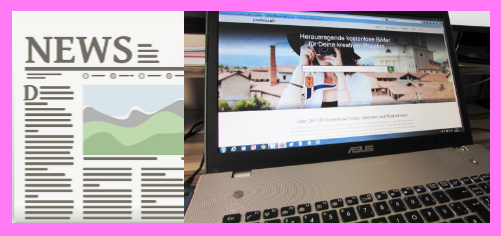

Newspaper Front Page:
- Team creates short list of interesting articles that leave audience wanting more
- Uses:
- summarize material
- practice different formats – news article, editorial, feature, advice column
- show how subjectivity plays into non-fiction pieces
- Play by play
- Topic search:
- teacher-assigned
- assign major role players and students brainstorm lesser characters
- choose from menus of topics and formats
- Identifying the audience:
- How will I need to title and write the article to catch the interest of _______?
- Brainstorm audience types that go with topics
- Select audience of let the WheelDecide
- Brainstorm newspaper title that will appeal to audience
- Gathering information:
- Use information in students notes and textbook
- Research information from valid internet sources
- Prewriting:
- Use templates to set word counts, image quantities and sizes per article
- Restrict to 1st page to make every word count
- Brainstorm content of specialty boxes – example: “Inside this issue”
- Drafting:
- Since articles are short, draft in class and provide students with in-progress feedback
- Revision:
- Meet in writer’s group and look for: (Also, see RAFT notes)
- Inclusion of descriptive helpful information
- Audience appeal
- Wording
- Writers take turns slowly reading aloud team members’ papers to listen for elements to polish and taking notes on feedback from team members
- Meet in writer’s group and look for: (Also, see RAFT notes)
- Editting:
- Type up and use spell and grammar check
- Check article word count to ensure they match templates
- Write in word processing software (simple) and then copy/paste into template software
- Sharing the Writing:
- Share in gallery style presentations
- Post high quality work on class bulletin board
- Other tips:
- Tech tip: Use same template software to create entry document to familiarize yourself with software
- Grading criteria:
- Catchy titles
- Accurate header information
- Consistent fonts (and other newspaper formatting details)
- Evidence of use of notes and research
- Cover who, what, when, where, why
- Lead sentences grab audience attention
- Information aligns to intended to topics
- Free of grammar and spelling errors
- Topic search:
Web Page
- Writing piece(s) published on the internet
- Uses:
- Uses of sub-pages and hyperlinks can add layers to information
- Develops understanding by having student impose structure on information
- Breaks up writing into small, connected chunks
- Practice 21st century literacy skills
- Motivate students with real, wide audiences
- Play by play:
- Getting started
- Internet research from valid sources
- Teach norm: If information is already in website, link it – don’t include it in writing to avoid plagiarism
- Select easy to use or familiar web-creation tool – poll students to say what they’ve already used, can place a few students in expert role to assist students with using website tool
- Working the room
- If possible, divide up class time between workshops (and other learning activities) and website work time
- Set milestone deadlines for key elements/decision – choosing a focus, completing research, creating graphic, drafting scripts, and publishing
- Provide feedback at all milestones
- Variations:
- Use thinking sheets to guide research and writing processes
- Can combine web question with website creation
- Getting started

Knowing a wide variety of possible writing projects can prevent writing products from feeling stale and repetitive.
The Newspaper front page can teach students how to represent a lot of essential information using a concise style that appeals to a specific audience. This exercise can show students how subjectivity affects non-fiction writing.
Creating websites can teach students how to represent information in short pieces connected by hyperlinks. The act of creating these layered, connected writing pieces can help students develop understanding by imposing structure on information. These products can motivate students to produce high quality work because of their access to wide audiences.

Preparation Steps
- Decide what writing assignments best align to current and future learning targets.
- Research and develop scaffolding and assessment activities and resources that go with selected writing assignment. See above and Writing articles for ideas.
- Research how to use tech tools that go with written products
- If possible, model use of software by creating launch materials using selected software
Early Implementation Steps
- Implement project that features selected writing activity.
- Have students reflect on how the steps in the writing process are affecting their content understandings and their writing skills.
Advanced Implementation Steps
- Re-use some of the positively tested strategies in previous projects to reinforce skills in current and future projects.
- Maintain a class blog or class magazine that features high quality student work.
- Have students gather feedback from audience members outside school to revise and refine work


